What's the point?
We all find ourselves in Class II rapids at some point; they may be part of the boogey water between the Class IVs or they may be the highlight drops of the stretch. Maybe Class II is at the uppermost reaches of your current abilities, or maybe Class II is your warmup. Either way, Class II stretches shouldn’t be neglected: they are excellent training grounds for honing technical skills and phenomenal areas to attempt uncomfortable or just-out-of-reach moves in a relatively low-consequence environment. Check out this video and information by our instructors to kick off your Class II skills sessions.
Skill One: Catch Every Eddy
Where eddies are abundant, challenging yourself to catch every eddy can make time pass incredibly slowly. Zigging and zagging through a rapid that is usually run straight down the middle offers ample opportunity to play with edging, stroke timing, and reading rivers. As you attempt to catch every eddy from the obvious to secret, take the time to work on your ferrying skills by adjusting boat and blade angle, edge, and boat positioning. Ferrying could be an entire skill-building segment of its own, but it’s great to incorporate into down-the-river activities as well.
Skill Two: Eddy Flips
Practicing rolling in calm water can be great for refining proper technique, but practicing in moving water will help you feel the nuances of the combat roll. For paddlers just figuring out what currents feel like when upside down, try low-flow eddies that won’t whirl you about as much while you’re holding your breath. For those who don’t often find themselves underwater because the quality of their braces keeps their hair dry, this can be a great opportunity to intentionally put yourself in swirly, boily, and dynamic head-under situations. Remember proper technique and keep yourself tucked forward in the shallow stuff, but practicing combat rolls as you enter or exit eddies can improve your underwater resiliency and make you more comfortable when the rolls really matter.
Skill Three: Going Backwards
What seems like a more advanced skill can be made highly manageable for most paddling skill levels. Entering and exiting eddies backwards is great for understanding boat control and the practice can come in incredibly handy on tight, narrow creeks where turning your boat around is not an option, but even simply spinning a boat backwards in a wave train can develop critical whitewater skills. Challenge yourself to use only back strokes as you navigate through Class II, just as you would traditionally use only forward strokes to move forwards throw flow. Sessioning this skill can improve situational awareness, strengthen the muscles that aren’t usually worked while paddling, and solidify your overall relationship with your boat.
Skill Four: One-Sided Paddling
By using only one blade of your paddle, you’ll likely be forced to practice different strokes than usual. The oft-used, vertical forward stroke will only get you so far if you can only do them on the left hand side, and you might need to go left so a sweep might not work out either. Think about both bow and stern draws, skulling, and odd combinations of strokes. Just as you might have a dominant hand in daily life, paddling on only one side can reveal strengths and weaknesses on different sides. Use your judgement for when you might need to quickly throw a stroke on your unchosen side to get to where you need to be – as with any of these skill-building tips and tricks, keep the environment and hazards in mind.
Skill Five: Hands-Free Boating
Can you even call it paddling if the point is not use your paddle or your hands? Is it just kneeing or footing instead? Anyways, hands-free boating is a great exercise for edge control, tilt, and subtle inputs from your body to your boat. Practice really tilting and edging to get the boat going where you want it. Feel how different pressures in your feet affect the pressure in your knees and therefore the rise of the boat. This slow-moving exercise relies heavily on river currents. The river will have the final say, so be prepared to add in a few strokes to move away from anything of high hazard or consequence.
Conclusion
Remember! These are all challenge-by-choice situations, and can be enacted by paddlers of most skill levels to some degree or another. As always when on whitewater, keep in mind your personal skill set, the hazards and consequences of the water around you, and the skills you want to improve. Let’s go kayaking!
Author: Jordan Rasure, Video: Andy Lockey, Paddlers: Leana Girton, Nathan Bond
